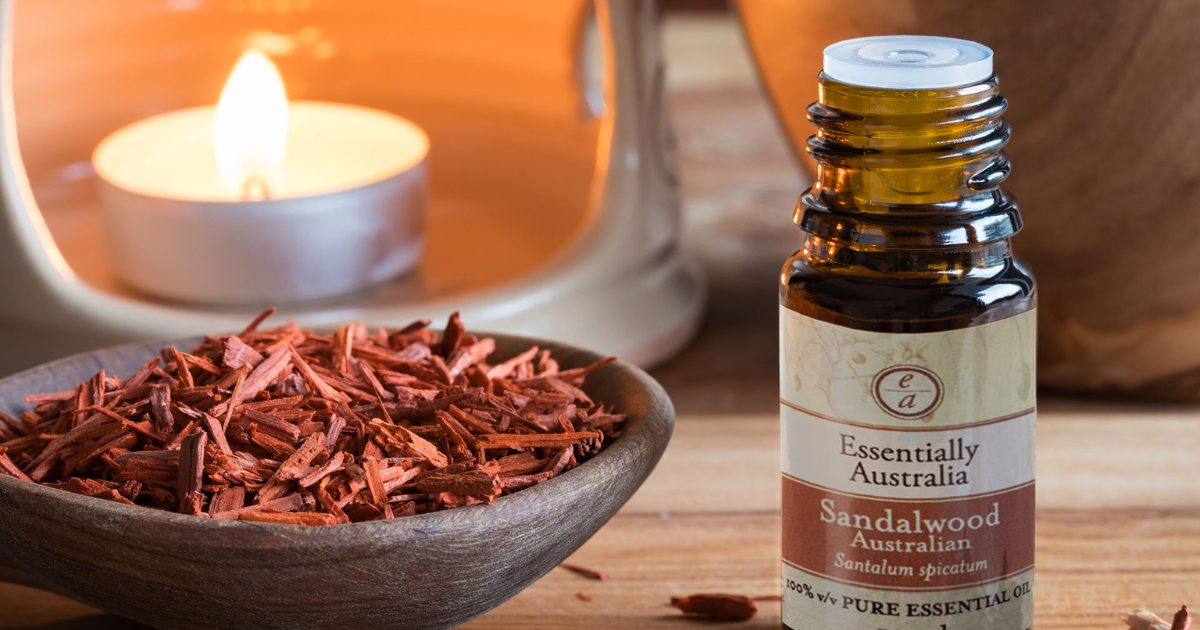Sandalwood essential oil has been valued for centuries in wellness, skincare, and spiritual practices. Known for its grounding aroma, this oil offers calming effects that support relaxation and balance. Many people explore sandalwood essential oil benefits for emotional well-being, meditation, and natural beauty care. It is widely used in holistic routines, from enhancing skin health to promoting restful sleep. In this guide, we’ll discover sandalwood essential oil benefits and uses that bring harmony to daily life. Let’s dive in.
What is Sandalwood Essential Oil?

Sandalwood essential oil is produced by steam distilling the heartwood of sandalwood trees. It is mainly derived from Santalum album in India and Santalum spicatum in Australia. The oil has a warm, sweet, woody fragrance widely used in perfumery, cosmetics, and aromatherapy. Rich in natural santalol compounds, it also holds significance in meditation, rituals, and spiritual healing practices.
What Are the Magical Properties of Sandalwood?
Sandalwood is revered across many traditions for its mystical and spiritual powers. In Hinduism and Buddhism, it purifies energy, enhances meditation, and opens the third eye for higher spiritual awareness. Magical lore describes sandalwood as an agent of protection, a cleanser of negative energy, and a purifier of sacred space. It also fosters spiritual connection and clairvoyance, often used in rituals to manifest intention, sacred devotion, or to align chakras. Sandalwood incense symbolizes spiritual clarity, ascent, and a bridge between the physical and spiritual realms.
What are the Benefits of Sandalwood Essential Oil
Here are the potential Sandalwood essential oil benefits:
Reduces Anxiety and Stress
Sandalwood essential oil has been shown to alleviate anxiety and stress. A study found that aromatherapy with sandalwood, lavender, and orange-peppermint oils significantly reduced self-reported feelings of anxiety. This suggests that sandalwood oil can be effective in managing anxiety symptoms.
Enhances Sleep Quality
Sandalwood oil may improve sleep quality. A study of healthy women found that a blend of bergamot and sandalwood essential oils improved sleep quality in 64% of participants. The soothing properties of sandalwood contribute to relaxation, making it beneficial for those seeking better sleep.
Supports Skin Health
Sandalwood oil possesses anti-inflammatory properties that are beneficial for skin health. Research indicates that sandalwood oil can aid in treating skin conditions like acne, psoriasis, and eczema. Its application may help reduce inflammation and promote healthier skin.
Provides Antioxidant Protection
Indian sandalwood oil exhibits antioxidant activity, protecting skin cells from oxidative stress caused by environmental factors. A study found that sandalwood oil scavenged reactive oxygen species and inhibited collagen breakdown, offering anti-aging benefits.
Exhibits Antimicrobial Properties
Sandalwood oil has demonstrated antimicrobial effects against various pathogens. A study revealed that sandalwood oils showed varying effects on Gram-negative bacteria such as Escherichia coli and Pseudomonas aeruginosa, indicating their potential as a natural antimicrobial agent.
How to Use Sandalwood Essential Oil

Here’s how to use Sandalwood essential oil:
Aromatherapy for Relaxation
Sandalwood essential oil is commonly used in aromatherapy to promote relaxation and reduce stress. Add a few drops to a diffuser or vaporizer. The calming scent can help lower anxiety, improve mood, and create a peaceful environment. Regular inhalation supports mental clarity and emotional balance, making it ideal for daily relaxation routines.
Meditation and Spiritual Practices
Sandalwood oil is often applied during meditation and spiritual rituals. Its grounding aroma helps deepen focus and mindfulness. You can inhale directly or diffuse it in the meditation space. Consistently using sandalwood oil during practice enhances spiritual awareness, promotes inner calm, and supports a sense of connection and balance throughout the session.
Skincare Application
Sandalwood oil benefits the skin due to its anti-inflammatory and antioxidant properties. Mix a few drops with a carrier oil or moisturizer and apply topically. It may help soothe irritated skin, reduce acne, and promote a healthy, glowing complexion. Regular use can improve skin texture, tone, and overall appearance naturally.
Bath and Body Relaxation
Add 5–10 drops of sandalwood essential oil to a warm bath for a relaxing experience. Its soothing aroma reduces tension, calms the mind, and relieves muscle stress. You can also combine it with Epsom salts or carrier oils for enhanced therapeutic effects. This simple ritual supports both physical and emotional wellness.
Perfume and Fragrance Use
Sandalwood oil is prized for its woody, sweet scent. You can use it as a natural perfume by blending it with a carrier or other essential oils. Its long-lasting aroma makes it ideal for personal fragrance, room sprays, or natural deodorants. Regular use leaves a subtle, calming scent that enhances mood and confidence.
Safety and Side Effects of Sandalwood Essential Oil
Sandalwood essential oil is generally considered safe for topical and aromatic use. A study found that only 0.1–2.4% of individuals exhibited hypersensitivity reactions to white sandalwood oil. However, allergic reactions, including dermatitis, have been reported in sensitive individuals.
Sandalwood oil has a long history of oral consumption without adverse effects. The German Commission E recommends a daily dosage of 1–1.5 grams for no more than six weeks.
Despite its safety profile, conducting a patch test before topical application is essential. Pregnant or breastfeeding individuals should consult healthcare providers before use.
While sandalwood essential oil is safe for most people, caution is advised for those with sensitive skin or underlying health conditions.
What Blends Best with Sandalwood Essential Oil?
Sandalwood essential oil pairs harmoniously with various essential oils, enhancing its grounding aroma. Lavender and sandalwood create a calming blend, ideal for relaxation and sleep. Frankincense complements sandalwood, promoting meditation and spiritual practices.
Ylang Ylang adds a floral sweetness, balancing emotional well-being. Citrus oils like sweet orange and lemon brighten sandalwood’s earthy tones. Spicy notes such as cinnamon and clove introduce warmth and depth. These combinations are widely used in aromatherapy to create balanced and therapeutic blends.
Can I Mix Sandalwood Oil with Coconut Oil?
Mixing sandalwood essential oil with coconut oil is safe and widely practiced. Coconut oil, used as a carrier, dilutes potent sandalwood oil effectively and reduces skin irritation—generally at a 2–3% dilution rate. Fractionated or refined coconut oil blends especially well and helps smooth application. This combination supports safe topical use, moisturizes, and carries aromatic benefits, making it ideal for massage, skincare, and DIY blends.
Read More: Ylang Ylang Essential Oil: Benefits and Uses
Conclusion
Sandalwood essential oil remains a timeless choice for wellness, beauty, and spiritual balance. Its calming aroma, healing qualities, and versatility make it valuable in skincare, meditation, and relaxation. Research highlights its anti-inflammatory, antimicrobial, and antioxidant properties, supporting natural health. When blended with oils like lavender or coconut, its benefits multiply. With mindful and safe use, sandalwood essential oil enriches daily routines, offering harmony, healing, and holistic well-being.

